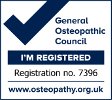Osteopathy as we get older
As we get older we can become frustrated with the fact that we experience more aches and pains, muscle problems, strains and injuries. This is due to our body losing elasticity and flexibility and its ability to recover quickly from exercise. In the case that these pains seem to come from nowhere for no apparent reason, it may be linked to what I call the end of the ‘reservoir of compensation’ whereby the emotional and physical traumas of life have led to body being unable to cope or compensate. It can feel as if the ‘straw has broken the camels back’ (although this may be in other areas of the body than the back)!
Osteopathic treatment can help you – or older relatives – restore your body’s ‘reservoir of compensation’ so that relapses of the current symptoms and/or further injuries can be prevented. Gentle soft tissue and articulatory techniques may be used amongst others to maintain health, improve mobility, circulation and immune function and reduce joint stiffness so that you can enjoy life to the full.
The British Osteopathic Association (BOA) recommends that, even if you do not consult an Osteopath, you apply these golden rules:
- Stretch daily to maintain tissue elasticity and joint mobility.
- Walk as much as possible to keep circulation healthy and maintain muscle tone.
- A daily rest, to recover energy for the rest of the day’s activities.
- Wearing trainers can help to reduce wear and tear to the knee and hip joints, and can also help reduce back pain when walking on hard pavements.
All that said, the BOA says that “…pain-killers are not the only solution for the aches and pains associated with ageing. For more permanent relief it is necessary to eliminate the underlying causes of pain, a job for which the osteopath is specifically trained”.







